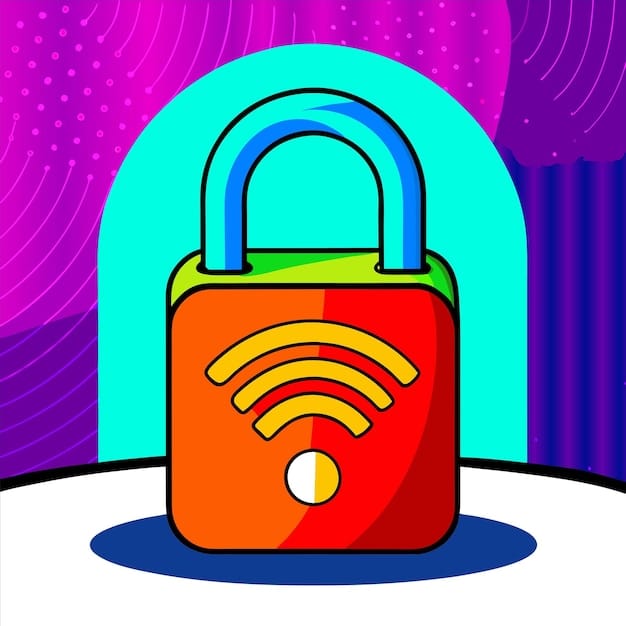Smart Home Privacy: Cybersecurity Tips for US Homes

Smart home privacy is crucial for US families, requiring robust cybersecurity measures to protect personal data and prevent unauthorized access to connected devices, ensuring a secure and private home environment.
Securing your digital life is more important than ever, especially as smart home devices become increasingly integrated into our daily routines. Understanding smart home privacy and implementing the right cybersecurity measures is essential for protecting your family and personal data in US homes.
Understanding the Risks to Smart Home Privacy
Smart home devices offer unparalleled convenience, but they also introduce potential privacy risks. These devices collect vast amounts of data, from your daily routines to your personal preferences, making them attractive targets for cybercriminals. It’s crucial to understand these risks to protect your family’s privacy.
Data Collection and Storage
Many smart home devices collect and store data about your usage patterns. This data can be used to personalize your experience, but it can also be vulnerable to breaches. Knowing what data is being collected and how it’s stored is the first step in securing your smart home.
Weak Security Protocols
Some smart home devices have weak security protocols, making them easy targets for hackers. Default passwords, outdated firmware, and lack of encryption can all create vulnerabilities that cybercriminals can exploit.

Here are several key areas where vulnerabilities often lie:
- Unsecured Networks: Default passwords on routers and Wi-Fi networks are easy to crack.
- Outdated Firmware: Devices with outdated software are prone to known vulnerabilities.
- Lack of Encryption: Unencrypted data transmissions can be intercepted and read by hackers.
Understanding these risks is the foundation for implementing effective cybersecurity measures to protect your smart home.
Securing Your Wi-Fi Network
Your Wi-Fi network is the gateway to your smart home, making it a critical area to secure. A strong, well-protected network can prevent unauthorized access to your devices and data. Several steps can be taken to enhance your network security.
Change Default Passwords
One of the most basic but crucial steps is to change the default password on your router. Default passwords are widely known and easily cracked by hackers. Choose a strong, unique password that is difficult to guess.
Enable WPA3 Encryption
WPA3 is the latest Wi-Fi security protocol, offering stronger encryption and authentication compared to older protocols like WPA2. Enabling WPA3 on your router can significantly enhance your network security.
Further steps to secure your Wi-Fi include:
- Guest Networks: Create a separate guest network for visitors to prevent them from accessing your primary network.
- Firewall: Ensure your router’s firewall is enabled to block unauthorized access.
- Regular Updates: Keep your router’s firmware up to date to patch security vulnerabilities.
By securing your Wi-Fi network, you create a strong foundation for protecting your smart home devices and data.

Managing Device Permissions and Privacy Settings
Smart home devices often come with a range of permission settings that dictate what data they can collect and how they can use it. Managing these settings is essential for protecting your privacy.
Review Default Permissions
Many devices come with default permission settings that may grant excessive access to your data. Take the time to review these settings and adjust them to minimize data collection.
Disable Unnecessary Features
Some devices have features that you may not need or want, such as location tracking or voice recording. Disabling these features can help reduce the amount of data collected by the device.
Key considerations for managing device permissions include:
- Microphone Access: Limit which devices have access to your microphone to prevent unauthorized eavesdropping.
- Camera Access: Control which devices have access to your camera to prevent unauthorized video recording.
- Location Tracking: Minimize location tracking to protect your privacy and prevent data breaches.
Taking control of your device permissions and privacy settings can significantly reduce your risk of privacy breaches.
Implementing Two-Factor Authentication (2FA)
Two-Factor Authentication (2FA) adds an extra layer of security to your smart home accounts. By requiring a second form of verification, such as a code sent to your phone, 2FA makes it much harder for hackers to access your accounts, even if they have your password.
Enable 2FA on All Accounts
Enable 2FA on all your smart home accounts, including your router, smart speaker, and other connected devices. This simple step can significantly enhance your security.
Use Authentication Apps
Consider using authentication apps like Google Authenticator or Authy to generate 2FA codes. These apps provide a more secure alternative to SMS-based 2FA, which can be vulnerable to interception.
Benefits of using 2FA include:
- Enhanced Security: Adds an extra layer of protection against unauthorized access.
- Reduced Risk: Makes it harder for hackers to compromise your accounts.
- Peace of Mind: Offers reassurance that your smart home is more secure.
Implementing 2FA is a simple yet effective way to protect your smart home from cyber threats.
Keeping Your Devices Updated
Keeping your smart home devices updated with the latest firmware and software is crucial for maintaining their security. Updates often include patches for newly discovered vulnerabilities, protecting your devices from potential attacks.
Enable Automatic Updates
Enable automatic updates whenever possible to ensure your devices are always running the latest software. This can help prevent vulnerabilities from being exploited.
Regularly Check for Updates
If automatic updates are not available, make it a habit to regularly check for updates and install them manually. This ensures that your devices are protected against the latest threats.
Key aspects of keeping devices updated include:
- Firmware Updates: Update your router and other network devices with the latest firmware.
- Software Updates: Update your smart home apps and device software regularly.
- Security Patches: Install security patches promptly to address vulnerabilities.
Regular updates are essential for maintaining the security of your smart home devices.
Monitoring and Managing Connected Devices
Regularly monitoring and managing your connected devices can help you identify and address potential security issues. This includes keeping track of all the devices connected to your network and monitoring their activity.
Create a Device Inventory
Create a list of all the smart home devices connected to your network. This inventory will help you keep track of your devices and identify any unauthorized devices.
Monitor Network Activity
Monitor your network activity for suspicious behavior, such as unusual data usage or unauthorized access attempts. This can help you detect and respond to potential security breaches.
Strategies for monitoring and managing devices include:
- Network Scanners: Use network scanners to identify all connected devices.
- Security Logs: Review security logs for suspicious activity.
- Device Audits: Conduct regular audits of your smart home devices to ensure they are secure.
By actively monitoring and managing your connected devices, you can proactively protect your smart home from cyber threats.
Educating Your Family About Cybersecurity Best Practices
Cybersecurity is a shared responsibility, and it’s important to educate your family about best practices. This includes teaching them how to recognize phishing scams, create strong passwords, and use the internet safely.
Teach Phishing Awareness
Teach your family how to recognize phishing scams and avoid clicking on suspicious links. Phishing is a common tactic used by cybercriminals to steal personal information.
Promote Strong Passwords
Encourage your family to create strong, unique passwords for all their online accounts. A password manager can help them manage their passwords securely.
Here are some points to promote good cyber habits:
- Safe Browsing: Educate your family about safe browsing habits, such as avoiding suspicious websites.
- Privacy Settings: Teach them how to adjust privacy settings on social media and other online platforms.
- Reporting Suspicious Activity: Encourage them to report any suspicious activity they encounter online.
By educating your family about cybersecurity best practices, you can create a more secure smart home environment for everyone.
| Key Element | Brief Description |
|---|---|
| 🔑 Secure Network | Change default passwords and enable WPA3 encryption for Wi-Fi. |
| 🛡️ Device Control | Manage permissions and disable unnecessary features on smart devices. |
| 🔄 Regular Updates | Keep devices updated to patch security vulnerabilities. |
| 👨👩👧👦 Family Education | Educate family members about cybersecurity best practices. |
Frequently Asked Questions (FAQ)
▼
Smart home privacy is important because these devices collect a lot of personal data. Securing them prevents misuse of this information and protects your family from potential cyber threats.
▼
Secure your Wi-Fi by changing the default password, enabling WPA3 encryption, and setting up a guest network. Regularly update your router’s firmware to patch any security vulnerabilities.
▼
2FA adds an extra layer of security by requiring a second form of verification, such as a code sent to your phone. It prevents unauthorized account access, even if someone has your password.
▼
You should update your smart home devices as soon as updates are available. Enable automatic updates if possible, or check manually at least once a month to stay protected from the latest threats.
▼
Teach your family to recognize phishing scams, create strong passwords, and browse safely. Emphasize the importance of protecting personal information and reporting any suspicious online activity.
Conclusion
Protecting your smart home privacy is an ongoing effort that requires vigilance and proactive measures. By understanding the risks, implementing strong security practices, and educating your family, you can create a more secure and private home environment in the US, ensuring your connected devices enhance rather than compromise your peace of mind.





